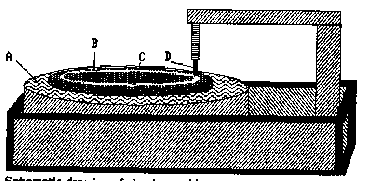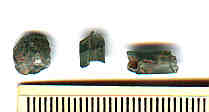Your path =Home>Ancient Beads> East Asia > Vietnam
Southeast Asian Bead Circle On-line Newsletter Vol. 1, No. 1
Some Notes on Beads in Vietnam
by Peter Francis, Jr.
My first trip to Vietnam early in 1995 was enjoyable and profitable, both from the personal and professional standpoint. A fairly complete report was published in the Margaretologist 8(2); here is a quick summary of what I have learned.
At the site of Trang Kenh in Hai Phong district, dated to ca. 1400 to 1000 BC, much work was expended in the production of jade ornaments. Nguyen Thi Kim Dung examined the ornaments and stone tools used to make them and experimented with a method that successfully duplicated the tool wear, the finished products and tool marks on the products.
|
|||||||
But, the work did not stop there. The drill bit was adjusted so that it would cut a smaller ring out of the remaining disc. Smaller and smaller rings were cut to be used for smaller hands and perhaps fingers. At the end, a very small plug was left, and this was made into a bead, being perforated with another jasper drill bit using a bow drill.
Excavations from the Sa Huynh period site of Giong Ca Vo in Ho Chi Minh City, dated to about 100 B.C., turned up some very interesting material. There were the common small monochrome drawn glass beads, likely from India (Indo-Pacific beads), but there was also: evidence for local glassmaking and the making of ornaments from glass.
|
Masses of partially fused, fritty glass were found at Giong Ca Vo. So were three holes about 80 cm in diameter filled with clean sand. If this weren't enough, glass ornaments of typical Sa Huynh style were found there in some numbers. These ornaments included bangles, not unlike some of the stone bangles at Trang Kenh, various earrings, including the so-called lingling-o type and one with two animal heads facing outwards.
Some analyses have been done on samples of this glass by Ian Glover and
Amy Salisbury (1997). It looks as though both remelted Indian glass and locally made
glass is found at the site.
These styles are closely connected with the sea-faring and far-traveling Sa Huynh people. The earring types are unique to them and found as far north as Hong Kong, as far west as Thailand, as far east as the Philippines and as far south as Indonesia. Some of the styles live today among some people in Southeast Asia, including the Kalinga of northern Luzon and on several Indonesian islands.
|
|||||||
Of the material from the Oc-eo culture, two things especially struck me. One is that among the beads excavated by the French from the site of Oc-eo (first to seventh century or so), now in the History Museum of Ho Chi Minh City, there are garnets. Of the 73 I examined, nearly half (43.8%) were apparently hessonite, a reddish-brown form of grossularite (there are many types of garnets). I was curious about this because at Arikamedu, in southeast India, which traded with Oc-eo, hessonite garnets accounted for only 3.5% of the total from the latest excavations.
All the books say gem-quality hessonite is virtually all from Sri Lanka. But, now I am beginning to believe that Vietnam was the source of these ancient ones. Hessonite is found in Lam Dong province, which would have been accessible to the Oc-eo people.
When I went through the classic literature on Sri Lanka, I was surprised to realize that precious stones were not discussed by early Greek and Roman writers, and the first definite mention of precious stones from the island is only in the mid sixth century. So, I now believe that hessonite was yet another item of trade between Oc-eo and Arikamedu 2000 or so years ago.
Some of Oc-eo beads excavated by the French are on display in the History Museum in Hanoi. One group was especially interesting. The excavation report (Malleret 1962:269) lumped two types of striped beads together, for what reason I cannot say. One of these were small drawn striped beads, made by one of the Indo-Pacific beadmaking sites.
The other, however, are striped and twisted beads, the small version of what the Indonesians call the "pelangi" (rainbow) bead. These are short cylinders with large holes and were no doubt made in East Java, along with several other beads.
Now we know two glass beads common to Oc-eo and East Java: the small "pelangi," and the "bird bead," with an image of a bird inside a frame on one side and usually a sunburst on the other. The small "pelangi" is no doubt East Javanese in origin. We still have to learn where the bird bead was made.
As I said before, I had a great time in Vietnam, and have many people to thank, especially Ian Glover of the Institute of Archaeology, who paved the way for me to go; Nguyen Thi Kim Dung, who was most informative; and Phuc Dinh Ngo, who made my stay in Ho Chi Minh City so pleasant.
References:
Fox, Robert B. 1970 The Tabon Caves Monograph No. 1, National Museum, Manila.
Francis, Peter Jr. 1995 Beads in Vietnam: An Initial Report. Margaretologist 8(2):3-9.
Malleret, Louis 1962 L'Archaeologie du Delta du Mekong, Tome 3, Le Civilization Materielle d'Oc-eo.
Ecole Français de Extrême Orient, Paris.
Salisbury, Amy and Ian Glover 1997 New Analyses of Early Glass from Thailand and Vietnam Bead Study Trust Newsletter 30:7-14.
__________________________________________________
Small Bead Businesses | Beading & Beadwork | Ancient Beads | Trade Beads
Beadmaking & Materials | Bead Uses | Researching Beads | Beads and People
Center for Bead Research | Book Store | Free Store | Bead Bazaar
Shopping Mall | The Bead Auction | Galleries | People | Events
The Bead Site Home | Chat Line | Contact Us | Site Search Engine | FAQ


